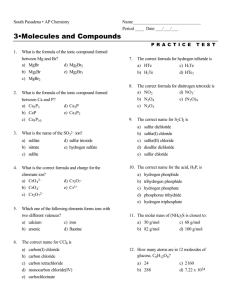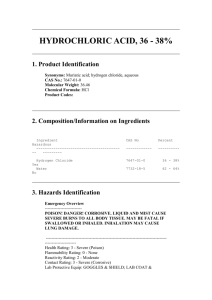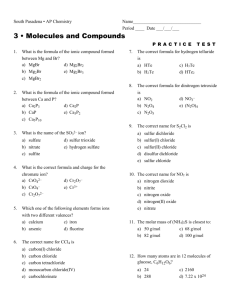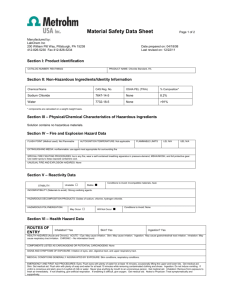GPS Safety Summary Hydrogen chloride HCl H Cl
advertisement
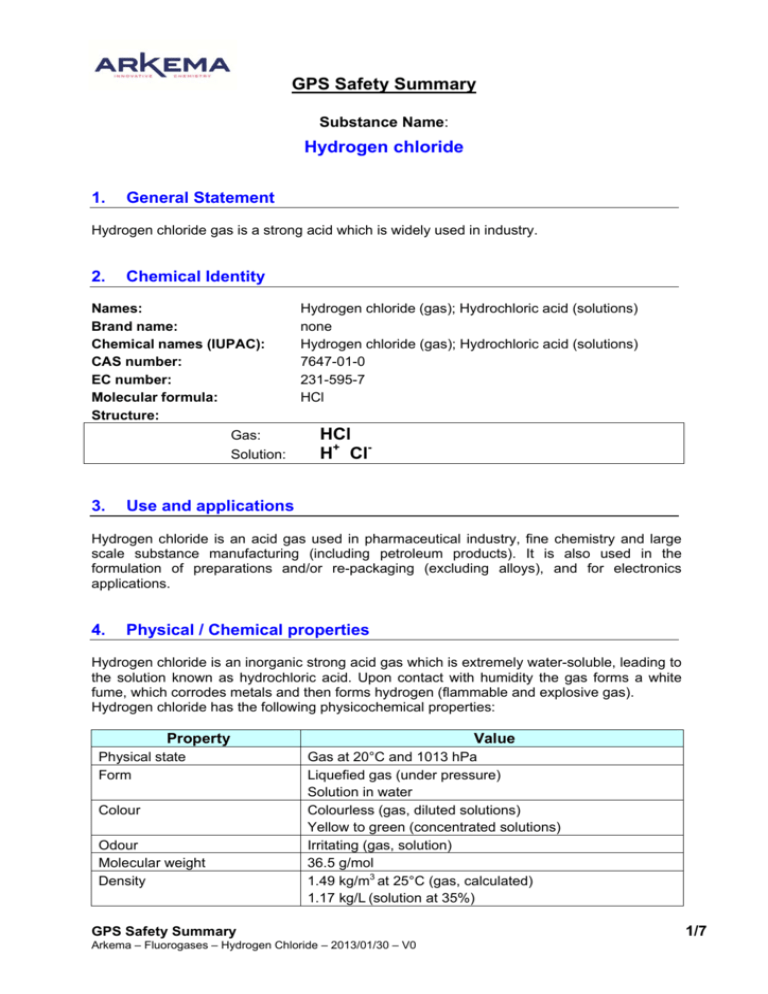
GPS Safety Summary Substance Name: Hydrogen chloride 1. General Statement Hydrogen chloride gas is a strong acid which is widely used in industry. 2. Chemical Identity Names: Brand name: Chemical names (IUPAC): CAS number: EC number: Molecular formula: Structure: Gas: Solution: 3. Hydrogen chloride (gas); Hydrochloric acid (solutions) none Hydrogen chloride (gas); Hydrochloric acid (solutions) 7647-01-0 231-595-7 HCl HCl H+ Cl- Use and applications Hydrogen chloride is an acid gas used in pharmaceutical industry, fine chemistry and large scale substance manufacturing (including petroleum products). It is also used in the formulation of preparations and/or re-packaging (excluding alloys), and for electronics applications. 4. Physical / Chemical properties Hydrogen chloride is an inorganic strong acid gas which is extremely water-soluble, leading to the solution known as hydrochloric acid. Upon contact with humidity the gas forms a white fume, which corrodes metals and then forms hydrogen (flammable and explosive gas). Hydrogen chloride has the following physicochemical properties: Property Physical state Form Colour Odour Molecular weight Density Value Gas at 20°C and 1013 hPa Liquefied gas (under pressure) Solution in water Colourless (gas, diluted solutions) Yellow to green (concentrated solutions) Irritating (gas, solution) 36.5 g/mol 1.49 kg/m3 at 25°C (gas, calculated) 1.17 kg/L (solution at 35%) GPS Safety Summary Arkema – Fluorogases – Hydrogen Chloride – 2013/01/30 – V0 1/7 Vapour pressure Freezing / boiling points Flash point Flammability Self-ignition temperature Explosive / oxidizing properties Water solubility Dissociation constant (pKa) Octanol-water partition coefficient (Log Kow) 5. 4.62 MPa at 25°C (gas) Not applicable / -85°C at 1013 hPa Not applicable (gas, solution) Non-flammable (gas, solution) Not applicable (gas, solution) Not expected based on structure 725 g/L at 20°C Strong acid: total dissociation in water Not applicable (inorganic) Health Effects The substance, both as a gas and as an aqueous solution, is a strong acid and is therefore strongly corrosive to human tissues. However, hydrochloric acid exists naturally as a major component of gastric acid, maintaining a pH of 1-2 in the stomach. Effect Assessment Acute Toxicity Oral / inhalation / dermal Irritation / corrosion Skin / eye / respiratory tract Sensitisation Toxicity after repeated exposure Oral / inhalation / dermal Genotoxicity / Mutagenicity Carcinogenicity Reproductive / Developmental Toxicity 6. Result Toxic by inhalation (gas). Risk of pulmonary edema (gas, solution). Risk of burns to the mouth, esophagus and stomach. Severely irritating to respiratory tract (gas, solution). Corrosive to skin and eye (gas, solution). Inhalation: no data. Dermal: not sensitizing (solution). Studies of prolonged inhalation in animals mainly showed local effects related to corrosion/irritation (gas). Dermal and oral: not relevant for a gas. Not expected to cause genetic effects based on available in vitro test data where the pH was properly controlled. No carcinogenic effects were noted in rats exposed by inhalation for their lifetime (gas). Not expected effects. to cause reproductive/developmental Environmental Effects In contact with water, Hydrogen chloride immediately dissociates and decreases the pH value. HCl is very toxic to algae and aquatic invertebrates and harmful to fish, however, due to its rapid dissociation and the buffer capacity of the environment, this substance is not classified. If emitted, the gas will quickly partition to the atmosphere where it will photodegrade into chloride free radical in a few weeks, while the solution will stay in water and partly volatilise to the atmosphere. Neither will partition significantly to soil or sediment, and they are not expected to bioaccumulate in the food chain as ions H+/Cl- are naturally present in living organisms. Effect Assessment Aquatic Toxicity Result Acute: very toxic GPS Safety Summary Arkema – Fluorogases – Hydrogen Chloride – 2013/01/30 – V0 Chronic: no data 2/7 Fate and behaviour Degradation/Persistence Bioaccumulation potential PBT / vPvB conclusion Result Non persistent: dissociates in all media except air. Not expected to bioaccumulate Not considered to be PBT* or vPvB** *: Persistent, Bioaccumulative and Toxic (PBT) **: very Persistent and very Bioaccumulative (vPvB) 7. Exposure 7.1 Human health Consumers: Consumers may use Hydrochloric acid solutions (maximum concentration: 20%) for private households. Exposure is limited by the warning effect of the well-known local corrosive/irritant properties: gloves are worn and inhalation is limited. Indirect exposure via the environment is not relevant: hydrochloric acid consists in ions H+ and Cl- which are commonly present in the environment, animals and humans. Workers: Hydrogen chloride and its solutions are industrially manufactured and used mainly in closed systems in a continuous or batch process, minimizing the occupational exposure potential. Workers may be exposed during cleaning, maintenance, transfer (notably for formulation), sampling and analysis. Some professional uses involve specific use processes such as roller application, spraying, treatment of articles, hand-mixing, etc. These processes involve higher exposure but workers are specifically trained and risks are controlled by adequate collective and individual risk management measures. Procedures, controls, collective and personal risk management measures are in place, which limit the occupational exposure during the manufacture and use of the substance. Workers who might accidentally come into contact with the gas or the solutions should follow the safety measures recommended in the relevant Extended Safety Data Sheet. Based on the risk assessment, the risk is controlled when activities are carried out under conditions recommended in the Extended Safety Data Sheet (see Chap. 8 and Exposure Scenarios). 7.2 Environment Hydrogen chloride and its solutions are industrially manufactured and used mainly in closed systems in a continuous or batch process, minimizing release to the environment. Procedures, controls and risk management measures are in place, which limit the environmental exposure. Professional uses such as activities related to cleaning may involve a higher environmental release fraction, but due to lower tonnages and wide-spread use, local releases are low. The main expected release compartment is the atmosphere for the gas, and water (with partial volatilisation to the atmosphere) for the solutions. In the aquatic environment, the solution immediately dissociates into ions H+ and Cl- which are normal environmental constituents. The relevant exposure determinant is more the effect on pH than the exposure to these ions. pH is buffered in environmental media. In the atmosphere, the gas photodegrades in a few weeks. Based on the risk assessment, the risk is controlled when activities are carried out under conditions recommended in the Extended Safety Data Sheet (see Chap. 8 and Exposure GPS Safety Summary Arkema – Fluorogases – Hydrogen Chloride – 2013/01/30 – V0 3/7 Scenarios). 8. Risk Management recommendations Human health measures Organizational Collect the latest available Safety Data Sheet. Implement good basic standards of occupational hygiene. Ensure operatives are well informed of the hazards and trained to minimise exposures. Handle and store according to the indications of the Safety Data Sheet. Engineering controls Use material of high integrity for loading and unloading (gas and concentrated solutions). Gas under pressure: avoid exposure of recipient to heat and sunlight. Provide appropriate local exhaust ventilation at points of emission. Ensure that eye- and handwash stations and safety showers are close to workstation locations. Safety goggles (with sideshields for Eye/Face protection: solutions) Anti-acid protective suit, safety boots Skin protection: Neoprene gloves (gas) or PVC gloves Hand protection: (solutions) tested to EN374 Respiratory protection: Gas or solution with important or long exposure: self-contained breathing apparatus. Solutions with low and short exposure: complete mask (A2B2 filter). Protection Environment protective measures Do not release in the environment. Monitor environmental pH in case of release. 9. Regulatory Information / Classification and Labelling 9.1 Regulatory Information This substance has notably been registered and assessed under: EU Regulation EC 1907/2006 (REACH), US EPA IRIS (Integrated Risk Information System), OECD SIDS (Screening Information Data Set) program. 9.2 Classification and labelling Under GHS, substances are classified according to their physical, health, and environmental hazards. The hazards are communicated via specific labels and the eSDS. GHS attempts to standardize hazard communication so that the intended audience (workers, consumers, transport workers and emergency responders) can better understand the hazards of the chemicals in use. Substances registered for REACH are classified according to CLP (EC) 1272/2008, implementation of the GHS in the European Union. For the particular case of Hydrogen chloride, classification and labelling depend on physical form (gas or solution) and concentration (for solutions) as detailed below: GPS Safety Summary Arkema – Fluorogases – Hydrogen Chloride – 2013/01/30 – V0 4/7 Gas: Classification Gases under pressure: Category Pressure gas Acute toxicity – Inhalation: Category 3. Skin corrosion: Category 1A. Serious eye damage: Category 1. Signal word Danger Pictograms GHS04: Gas cylinder GHS06: Skull and crossbones GHS05: Corrosion Hazard statements H280: Contains gas under pressure; may explode if heated. H331: Toxic if inhaled. H314: Causes severe skin burns and eye damage. Solution at > 25%: Classification Corrosion to metals: Category 1 Skin corrosion: Category 1B. Serious eye damage: Category 1. Specific target organ toxicity - single exposure (inhalation): Category 3; May cause respiratory irritation. Signal word Danger Pictograms GHS05: Corrosion GHS07: Exclamation mark Hazard statements H290: May be corrosive to metals. H314: Causes severe skin burns and eye damage. H335: May cause respiratory irritation. GPS Safety Summary Arkema – Fluorogases – Hydrogen Chloride – 2013/01/30 – V0 5/7 Solution at > 10 – < 25%: Classification Corrosion to metals: Category 1 Skin irritation: Category 2. Eye irritation: Category 2. Specific target organ toxicity - single exposure (inhalation): Category 3; May cause respiratory irritation. Signal word Attention Pictograms GHS05: Corrosion GHS07: Exclamation mark Hazard statements H290: May be corrosive to metals. H315: Causes skin irritation. H319: Causes serious eye irritation. H335: May cause respiratory irritation. Solution at > 0.1 – < 10%: Classification Corrosion to metals: Category 1 Signal word Attention Pictogram GHS05: Corrosion Hazard statement H290: May be corrosive to metals. 10. Contact Information within Company For further information on this substance or product safety summary in general, please contact: ICCA portal where the GPS Safety Summary is posted: http://www.icca-chem.org/en/Home/ICCA-initiatives/global-product-strategy/ GPS Safety Summary Arkema – Fluorogases – Hydrogen Chloride – 2013/01/30 – V0 6/7 11. Date of Issues / Revision Date of issue: 2013/01/30 Date of revision: 12. Disclaimer The information contained in this paper is intended as advice only and whilst the information is provided in utmost good faith and has been based on the best information currently available, is to be relied upon at the user’s own risk. NO WARRANTY OF FITNESS FOR ANY PARTICULAR PURPOSE, WARRANTY OF MERCHANTABILITY, OR ANY OTHER WARRANTY, EXPRESSED OR IMPLIED, IS MADE CONCERNING THE INFORMATION PROVIDED HEREIN. No liability will be accepted by ARKEMA for damages of any nature whatsoever resulting from the use of or reliance on the information. GPS Safety Summary Arkema – Fluorogases – Hydrogen Chloride – 2013/01/30 – V0 7/7

